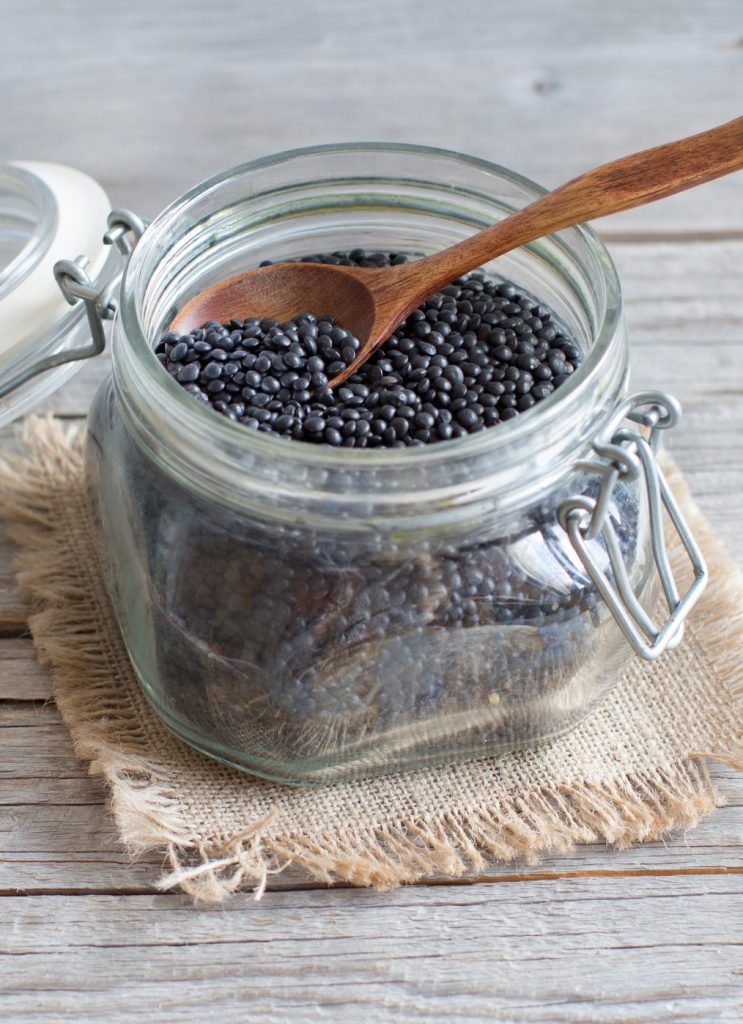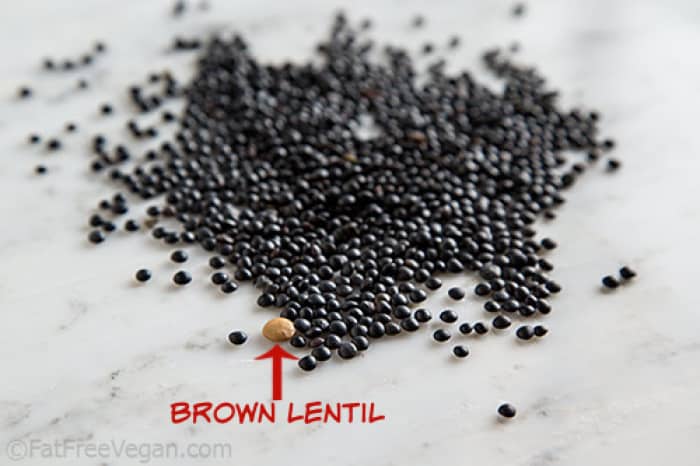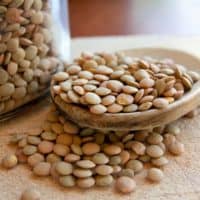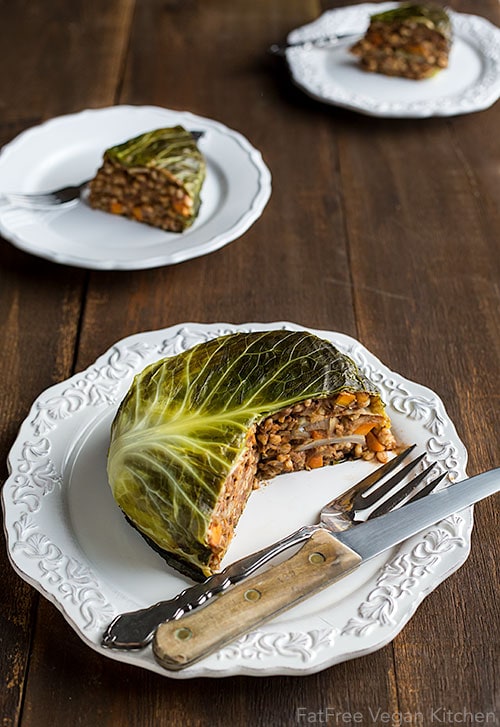Protein-Packed Black Beluga Lentils
Tiny, dark, and dense, black lentils–also known as Beluga Lentils–are named for the caviar they amazingly resemble. They are inexpensive, easy to cook, protein-packed, and delicious.

Unlike other lentils that tend to get mushy when cooked, beluga lentils hold their shape and al dente texture during the cooking process.
If you are looking for foods with protein, there are plenty of plant-based protein-filled foods to choose from. We also have other lentil recipes like lentil artichoke stew and lentil sloppy joes that you might like to try.
What are lentils anyway?
Lentils are lens-shaped, mini-sized legumes that come in a rainbow of different colors and can be used in a wide variety of recipes including side dishes as well as main entrees. Because they are inexpensive and easy to store, they are popular all over the world.
A staple ingredient in many recipes throughout Asia and the Mediterranean, lentils are packed with protein, fiber, and antioxidants. As a matter of fact, when compared to 10 other legumes, lentils come out on top for antioxidant content in research studies.
There are a lot of different kinds of lentils, but the most commonly used are green, brown, red, and black varieties.
Protein-packed lentils
Lentils are an excellent source of protein with nearly 18 grams of protein for every cup of cooked lentils which makes them a great meat alternative.
They are also high in fiber and contain a wide range of phytonutrients and antioxidants that help protect against chronic diseases, such as heart disease and type 2 diabetes.

Black beluga lentils
Beluga lentils are one of the most versatile because they hold their shape during cooking.
Though they are tiny, the black lentils provide a mighty dose of nutrition in every single bite! Take a look at the picture below comparing the size of beluga lentils with brown lentils.

Should you soak black lentils?
Black lentils, like other lentils, do not require soaking. Cooking instructions for most lentils are relatively the same. The main difference is simply the amount of time to cook them.
These are the steps to take when cooking lentils:
Rinse lentils well under warm water using a mesh strainer. I will tell you from experience that, due to their small size, lentils will fall right through a regular colander, so invest in a mesh sieve like the one I use linked here. You’ll find that they are handy for rinsing rice, quinoa, and many other grains as well.
Make sure to pick out any pebbles or other debris.
Place the lentils in a stockpot and add 2 cups of water or vegetable broth for every 1 cup of lentils. You can add more liquid as they are cooking if they begin to look too dry.
Bring the pot to a boil then reduce the heat to simmer. Cover and allow to cook 20-25 minutes (brown, green, and black lentils), stirring occasionally.
Add liquid if necessary and continue cooking until the lentils are tender but not mushy.
Remove from heat and serve immediately.
The recipe card at the bottom of the page has the full list of ingredients with measurements and instructions.
Tips for cooking lentils
- Red lentils are best reserved for soups and curries because they become mushy once cooked.
- Adding too much liquid during cooking can leach nutrients from lentils, so it is best to use just enough water or veggie broth for them to absorb and cook in. More liquid can always be added as they cook if needed. There is no need to presoak lentils before cooking as is required with other legumes. This makes them a great option when you’re in a hurry.
- Don’t overcook them because they will become mushy.
- Cooked lentils make a delicious addition to garden and pasta salads. They are also terrific in chili, soups, and stews.
Black Lentil Recipes
If you're ready to get started with some deliciously healthy black beluga lentils, check out these three vegan oil-free recipes. A recipe card for basic stovetop cooking instructions can be found further down this page. Click on each of the photos, recipe titles, or 'Get the Recipe' buttons to see full recipes with ingredients, measurements, instructions, and a print button.
This is probably the fastest chili I’ve ever made without using canned beans. The secret is black beluga lentils, which cook quickly and keep their shapes, giving this chili a very hearty texture.
I decided to call it a main dish rather than a side and 4 servings rather than 6 because I know that when I go to this much trouble to make a dish, I’m not cooking much else!
Rich and hearty yet oil-free and refined sugar-free vegan gluten-free brownies using black lentils for perfect texture and moistness. Moreover, they are not only gooey and delicious but also super easy to make.
More lentil recipes
Want to Save This Recipe?
Enter your email & I’ll send it to your inbox. Plus, get great new recipes from me every week!
By submitting this form, you consent to receive emails from EatPlant-Based

How to cook lentils
Ingredients
- 1 cup dry lentils
- 2 cups water or veggie broth
Instructions
- Rinse lentils well under warm water using a mesh strainer. I will tell you from experience that, due to their small size, lentils will fall right through a regular colander, so invest in a mesh sieve like the one I used linked here. You’ll find that they handy with rinsing rice, quinoa, and many other grains as well.
- Make sure to pick out any peoples or other debris.
- Place the lentils in a stockpot and add 2 cups of water or vegetable broth for every 1 cup of lentils. You can add more liquid as they are cooking if they begin to look too dry.
- Bring the pot to a boil then reduce the heat to simmer. Cover and allow to cook 20-25 minutes (brown, green, and black lentils), stirring occasionally.
- Add liquid if necessary and continue cooking until the lentils are tender but not mushy.
- Remove from heat and serve immediately.
Video
Notes
Nutrition
Disclaimer
To obtain the most accurate representation of the nutritional information in a given recipe, you should calculate the nutritional information with the actual ingredients used in your recipe, using your preferred nutrition calculator. You are solely responsible for ensuring that any nutritional information provided is accurate, complete, and useful.
About Terri Edwards
Hi guys! I am the content creator behind EatPlant-Based and a licensed Food for Life instructor with the Physicians Committee for Responsible Medicine. I am passionate about sharing healthy recipes and tips to empower others to get healthy. I’m so glad you’re here! Read More…




